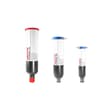LOCTITE ECCOBOND 3707
Harmonization Code : 3506.10.00.00 | Prepared glues and other prepared adhesives, not elsewhere specified or included; products suitable for use as glues or adhesives, put up for retail sale as glues or adhesives, not exceeding a net weight of 1 kg
Main features
- UV & Heat cure
- One component
- BGA cornerbond
Product Description
LOCTITE ECCOBOND 3707 UV curable edgebond is designed for bonding various types of electronic components on a PCB. It mainly plays a structural role in the packaging process.
LOCTITE ECCOBOND 3707 is a white, single component epoxy that is typically used for UV Curable CSP (Chip Scale Packages) and as a BGA (Ball Grid Array) Cornerbond.
UV Cure:
- >3,000mJ or
- >30 seconds @ 100 mW/cm²
Minimum intensity of 100 mW/cm² is recommended for the UV lamp
Oven Cure:
- 2 minutes @ 130°C
Technical Specifications
| General Properties | |||||||
| |||||||
| Pot Life Pot Life Pot life is the amount of time it takes for the viscosity of a material to double (or quadruple for lower viscosity materials) in room temperature after a material is mixed. It is closely related to work life but it is not application dependent, less precise and more of a general indication of how fast a system is going to cure. | 168 hours | ||||||
| Physical Properties | |||||||
| Viscosity Viscosity Viscosity is a measurement of a fluid’s resistance to flow. Viscosity is commonly measured in centiPoise (cP). One cP is defined as the viscosity of water and all other viscosities are derived from this base. MPa is another common unit with a 1:1 conversion to cP. A product like honey would have a much higher viscosity -around 10,000 cPs- compared to water. As a result, honey would flow much slower out of a tipped glass than water would. The viscosity of a material can be decreased with an increase in temperature in order to better suit an application | 9,595 mPa.s | ||||||
| Thermal Properties | |||||||
| |||||||
| Glass Transition Temperature (Tg) Glass Transition Temperature (Tg) The glass transition temperature for organic adhesives is a temperature region where the polymers change from glassy and brittle to soft and rubbery. Increasing the temperature further continues the softening process as the viscosity drops too. Temperatures between the glass transition temperature and below the decomposition point of the adhesive are the best region for bonding. The glass-transition temperature Tg of a material characterizes the range of temperatures over which this glass transition occurs. | 53 °C | ||||||
Additional Information
UV/Light Cure Strengths
- One component
- No solvents
- Very fast room temperature cure
- Cure on demand-facilitates parts alignment
- Less equipment space and energy
- Fast through put-low WIP
UV/Light Cure Limitations
- Sensitive to light-requires special space lighting
- Oxygen inhibits cure
- Line of sight cure- shadowed areas require secondary cure
- High CTE- fillers used to lower CTE block UV/light




